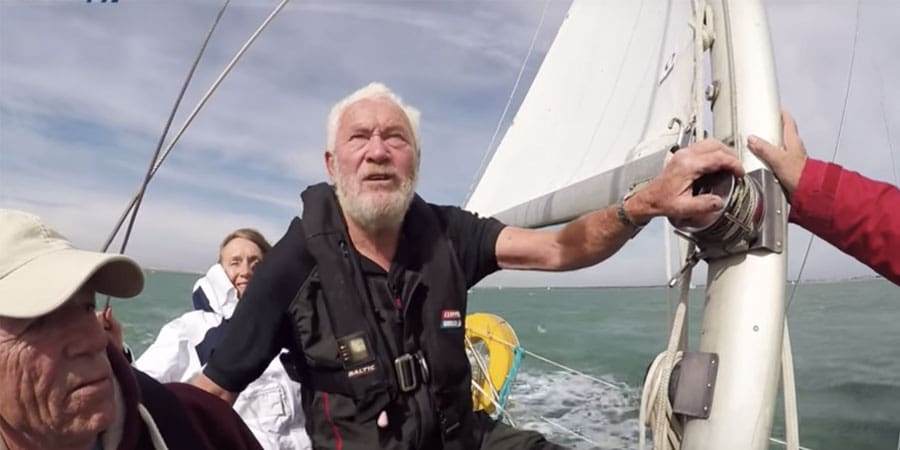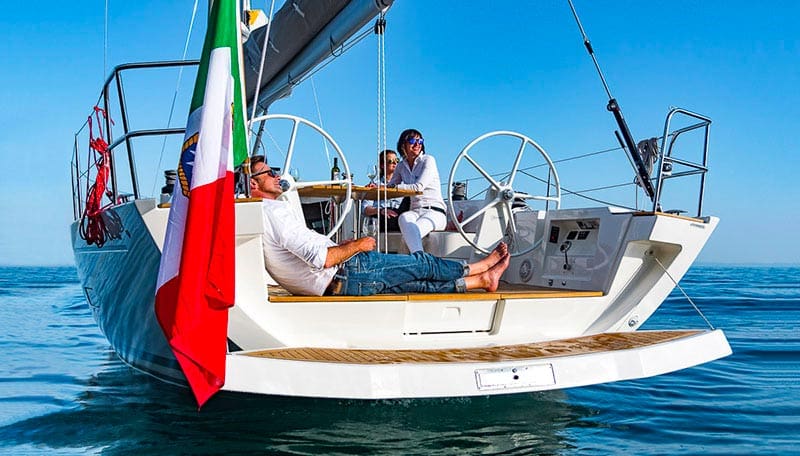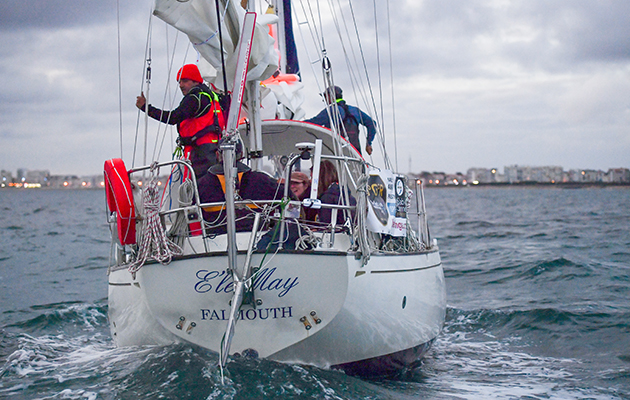Stage Photo: Alain Delord sailing his ARCHAMBAULT 35 ” TCHOUK TCHOULK NOUGAT” solo around the world. By VoilesetVoiliers Photo@ALESSANDRO GUI
The Southern Ocean is tough on GGR boats as it is for all who venture south. It’s a place of extreme beauty, a true wilderness that captures the imagination of sailors and reminds them of their insignificance. Nowhere else on earth is like it. It’s power is unquestioned and unchallenged. You never beat it, just move and bend with it in deep respect. You venture south at your own risk with an open mind in the knowledge that you may not return. The allure of the Great Southern Ocean is steeped in history and folklore. For many the attraction is to successfully round Cape Horn, a moment mixed with pride, excitement, awe and most often great relief.To succeed you must believe in yourself and your ability, TRUST YOUR BOAT and prepare for the worst.
JEAN LUC VAN DEN HEEDE first coined the fun phrase Petit Escargot (little snail) describing the 36ft full displacement yachts of the GGR when he joined the Race in 2015. He has sailed five times solo around the Globe in larger boats up to 80 ft long including his BOC and VENDEE GLOBE yachts. He knew the challenge was tough, indeed very tough but stakes his life on his Rustler 36 MATMUT as a safe ocean-going yacht, up to the demands of the Southern Ocean and right for this simple yet serious adventure.
The essence of the Golden Globe Race rests with strong honest boats, basic reliable sailing systems, no computers, world class safety gear and full risk minimization. It’s a UNIQUE challenge, accessible and affordable to any man or woman with the passion and desire to do it.
The choice of boats for the GGR is defined within well-conceived parameters specifically relative to the event. At 32-36 ft they are proven ocean voyaging yachts conceived by respected designers. The keels, rudders and hulls are over engineered by modern standards. These designs are not prone to damage from hitting underwater objects and their long keels track well under windvane self-steering even in heavy weather.
Only six of the original 17 starters in the GGR are still sailing and there have been five Southern Ocean dismasting. Some may think this is because the boats are too small, too slow and cannot outrun Southern Ocean storms. History does not support this assumption. Many ordinary well-prepared yachts from 22ft to 38ft have safely solo circumnavigated via the Great Capes and continue to do so. Speed may sometimes help in the Southern Ocean, but many modern fast yachts are still overcome. My 50ft 1990 BOC Challenge yacht Buttercup and another entrant Kanga Birtles in his 60ft yacht could not outrun the same storm and we both rolled 360. (Both rigs survived) Watch the video here
Typical racing sailors would never use these Petit Escargot for normal racing and have trouble coming to terms with their features and ocean-going ability. Most have never sailed them, nor been in the Southern Ocean and have not used windvane self-steering. They feel more modern designs with fin keels and outboard rudders may be safer. Again, history does not support this assumption. Modern fin keel lightweight surfing boats often need electric Auto pilots to steer, require constant human input and effort to control these sometimes-unforgiving designs in heavy weather. These designs simply have less ability to look after themselves. GGR style boats are much more forgiving in heavy weather and sail well under wind vanes without the need for electrical power.
A few years ago, I was involved in the RESCUE of French solo sailor ALAIN DELORD, sailing a fast, light modern fin keel 35ft yacht solo around the globe. He was unable to control his boat in a storm and then was dismasted 440 miles south of Hobart in Tasmania, spending four days in a life raft before we were able to recover him.
Watch the Video here .
Read the story here.
Read the FRENCH story here
Collectively I have spent 3.5years of my life in the Southern Ocean over 22 years on yachts and small expedition ships and have 48 years sailing experience. I have seen her moods. I know that the better prepared you are the more luck you have, but I also know that sometimes, you can have the best prepared boat with the best skipper, yet that GUARANTEES NOTHING.
History makes this very clear . Last year’s OSTAR solo transatlantic race saw FIVE finishers from 15 starters. The early Vendee Globe races saw on average only HALF the fleet finish. In 1996-97 only SIX of 16 starters finished and in the 2008-9 Vendee Globe 18 of the 29 starters FAILED TO FINISH. The retirement statistics of problems (3 keels, 3 steering and 7 mast issues) make interesting reading.
Roland Jourdain (Veolia Environment) day 85: lost keel.
Jean Le Cam (VM Matériaux) day 58: lost keel bulb, capsized
Jonny Malbon (Artemis) day 56: delaminated mainsail
Jean-Pierre Dick (Paprec-Virbac 2) day 53: lost port rudder
Derek Hatfield (Algimouss Spirit of Canada) day 50: broken spreaders
Sébastien Josse (BT) day 50: broken rudder system
Yann Eliès (Generali) day 40: fractured femur
Mike Golding (Ecover 3) day 38: dismasted
Jean-Baptiste Dejeanty (Groupe Maisonneuve) day 37: faulty halyards, broken auto-pilot
Loïck Peyron (Gitana Eighty) day 36: dismasted
Bernard Stamm (Cheminées Poujoulat) day 36: ran aground
Dominique Wavre (Temenos) day 35: damaged keel box
Unai Basurko (Pakea Bizkaia) day 28: faulty starboard rudder box
Jérémie Beyou (Delta Dore) day 17: damaged rig
Alex Thomson (Hugo Boss) day 6: cracked hull
Yannick Bestaven (Energies Autour du Monde) day 4: dismasted
Marc Thiercelin (DCNS) day 4: dismasted
Kito de Pavant (Groupe Bel) day 4: dismasted
The 2018 Golden Globe Race is re-creating and making history. It is new, innovative and different in many ways. It is seen as a Cultural Renaissance in sailing. There is no such thing as the PERFECT BOAT in any ocean or situation. The GGR Petit Escargots are RIGHT FOR THE SOUTHERN OCEAN and what is quickly becoming known as the TOUGHEST RACE IN THE WORLD.
https://goldengloberace.com/talking-boats/























